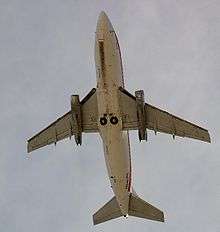Western Airlines Flight 470
 A Boeing 737 of Western Airlines, sister ship to the aircraft which crashed | |
| Accident summary | |
|---|---|
| Date | March 31, 1975 |
| Summary | Runway overrun |
| Site | Casper/Natrona County International Airport, Natrona County, near Casper, Wyoming, USA |
| Passengers | 93 |
| Crew | 6 |
| Injuries (non-fatal) | 4 |
| Fatalities | 0 |
| Survivors | 99 (all) |
| Aircraft type | Boeing 737-200 |
| Operator | Western Air Lines |
| Registration | N4527W |
| Flight origin | Stapleton International Airport, Colorado, United States |
| Destination | Casper/Natrona County International Airport, Wyoming, United States |
Western Air Lines Flight 470 suffered an air accident on March 31, 1975. The Boeing 737-200 aircraft overran the runway at Casper/Natrona County International Airport, near Casper, Wyoming, USA after a flight from Stapleton International Airport, Colorado, USA. Four of the 96 passengers and 6 crew were injured (none were killed), and the aircraft was damaged beyond repair.
Aircraft
The aircraft involved was a Boeing 737-200 (Registration: N4527W) that was only 11 months and 5 years old at the time of the accident.
Accident
Western Air Lines Flight 470 departed Stapleton International Airport at 07:03 on a short domestic flight to Casper/Natrona County International Airport with 93 passengers and 6 crew. The aircraft climbed to its cruising altitude of FL220. At 07:36, following a descent to 12,000 feet, the flight crew contacted Casper approach control and advised that the flight was about 12 miles south of the Evansville Intersection. At that time, the controller cleared the flight to use the localizer back course approach for runway 25, to circle to runway 3, or to land straight in. The weather reported to the crew indicated poor visibility with light snow falling and wind 040deg at 9 knots. One minute later, the approach controller advised that "runway 7/25 has been plowed. There's about a 1/4-inch of powder snow on it. Braking action reported, Convair 580, as poor. Runway 3/21 is being plowed at this time." At 07:51, Flight 470 reported at the Henning Intersection and was cleared to contact the Casper Tower. The tower controller cleared the flight to land on runway 25 and gave the wind as 030deg at 8 knots. The flight was also advised by the controller that a disabled snow blower was "just west of the intersection runway 21, left side runway 25, on the edge ...." At 07:41:42, the first officer called out "thousand to go to the field." At 07:42:09, the first officer called "approaching minimums," and 12 seconds later, he called "just about at minimums." The aircraft then flew level for a few moments at the minimum descent altitude (MDA). At 07:42:25, the first officer called the runway in sight directly below the aircraft. At that time airspeed was 150 knots and the flaps were at 25deg. The first office then set the flaps at 30deg as the captain initiated the final descent. The aircraft crossed the threshold at reference speed +15 knots. The aircraft touched down 2375 feet from the departure end of the runway, about 6,306 feet from the approach end of the runway. The aircraft went off the departure end of the runway to the right of the centerline. After striking several metal stanchions in the first row of terminal bar lights, which were located 200 feet off the end of the runway, the aircraft struck a shallow irrigation ditch 280 feet off the runway end. The aircraft veered farther to the right and stopped about 800 feet beyond the departure end of the runway. There was no fire and the aircraft was damaged but only four passengers were injured. All 99 passengers and crew on board flight 470 got off the aircraft and survived.


Investigation
The National Transportation Safety Board report determined that the cause of the accident was the failure of the pilot-in-command to exercise good judgment when he failed to execute a missed approach and continued a non-precision approach to a landing without adequately assessing the aircraft's position relative to the runway threshold. Contributing to the accident were the excessive height and speed at which he crossed the approach end of the runway and the failure of other flight crew members to provide him with required callouts. The accident report was released on October 30, 1975, seven months after the accident.
References
- Aviation Safety Network accident description
- Photos of involved aircraft
- National Transportation Safety Board accident report
| ||||||
Coordinates: 42°54′31″N 106°28′56″W / 42.90861°N 106.48222°W